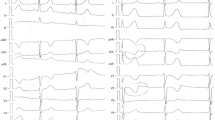Abstract
Psychostimulants (methylphenidate and amphetamine salt) are the pharmacologic treatment of choice for children with attention-deficit/hyperactivity disorder. However, psychostimulants have been linked to a variety of vascular problems, including peripheral vasculopathy. This article describes four boys with attention-deficit/hyperactivity disorder who developed vasculopathy during treatment with psychostimulants.
Similar content being viewed by others
References
Papers of particular interest, published recently, have been highlighted as: •• Of major importance
Guevara J, Lozano P, Wickizer T, et al.: Psychotropic medication use in a population of children who have attention-deficit/hyperactivity disorder. Pediatrics 2002, 109:733–739.
Sadeghian H: Lacunar stroke associated with methylphenidate abuse. Can J Neurol Sci 2004, 31:109–111.
Thai DL, Yurasists LN, Rudolph GR, et al.: Comparative pharmacokinetics and tissue distribution of the d-enantiomers of para-substituted methylphenidate analogs. Drug Metab Dispos 1999, 27:645–650.
Stahl SM: Essential psychopharmacology, neuroscientific basis and practical applications. In Cognitive Enhancers, edn 2. Edited by Stahl SM. Cambridge, United Kingdom: Cambridge University Press; 2004:461–466.
Dulcan MK, Lizarralde C: Helping parents, youth, and teachers understand medications for behavioral and emotional problems: a resource book of medication information handouts. In Stimulants, edn 2. Edited by Dulcan MK, Lizarralde C. Washington, DC: American Psychiatric Publishing; 2003:75–80.
Kokkinos J, Levine SR: Possible association of ischemic stroke with phentamine. Stroke 1993, 24:310–313.
Jefferson HJ, Jayne DR: Peripheral vasculopathy and nephropathy in association with phentermine. Nephrol Dial Transplant 1999, 14:1761–1763.
Leithauser B, Langheinrich AC, Rau WS, et al.: A 22-year-old woman with lower limb arteriopathy. Buerger’s disease, or methamphentamine- or cannabis-induced arteritis? Heart Vessels 2005, 20:39–43.
Bingham C, Beaman M, Nicholls AJ, Anthony PP: Necrotizing renal vasculopathy resulting in chronic renal failure after ingestion of methamphetamine and 3,4-methylenedioxymethamphetamine (‘ecstasy’). Nephrol Dial Transplant 1998, 13:2654–2655.
•• Syed R, Moore T: Methylphenidate and dextroamphetamine-induced peripheral vasculopathy. J Clin Rheumatol 2008, 14:30–33. This was a case report of four patients treated with MPH (n = 2) or dextroamphetamine (n = 2) presenting with acral cyanosis, livedo reticularis, or RS potentially contributing to vasculopathy.
•• Goldman W, Seltzer R, Reuman P: Association between treatment with central nervous system stimulants and Raynaud’s syndrome in children. Arthritis Rheum 2008, 58:563–566. This was a retrospective case-control study of pediatric rheumatology patients (with and without RS) that examined the association between development of RS and CNS stimulants used to treat ADHD.
Sule SD, Wigley FM: Current rheumatology: diagnosis and treatment. In Raynaud Phenomenon. Edited by Imboden J, Hellmann DB, Stone JH. Columbus, OH: McGraw-Hill; 2004:183–185.
Disclosure
Drs. Ronald and Elizabeth Weller are co-owners of the Children’s Interview for Psychiatric Syndromes (and the parent’s version) and have received annual royalties from copyright ownership of this diagnostic interview. Dr. Elizabeth Weller was the principal investigator for a grant from GlaxoSmithKline to investigate the tolerability and efficacy of lamotrigine in children and adolescents diagnosed with bipolar disorder. No other potential conflicts of interest relevant to this article were reported.
Author information
Authors and Affiliations
Corresponding author
Rights and permissions
About this article
Cite this article
Yu, Z.J., Parker-Kotler, C., Tran, K. et al. Peripheral Vasculopathy Associated with Psychostimulant Treatment in Children with Attention-Deficit/Hyperactivity Disorder. Curr Psychiatry Rep 12, 111–115 (2010). https://doi.org/10.1007/s11920-010-0093-y
Published:
Issue Date:
DOI: https://doi.org/10.1007/s11920-010-0093-y




